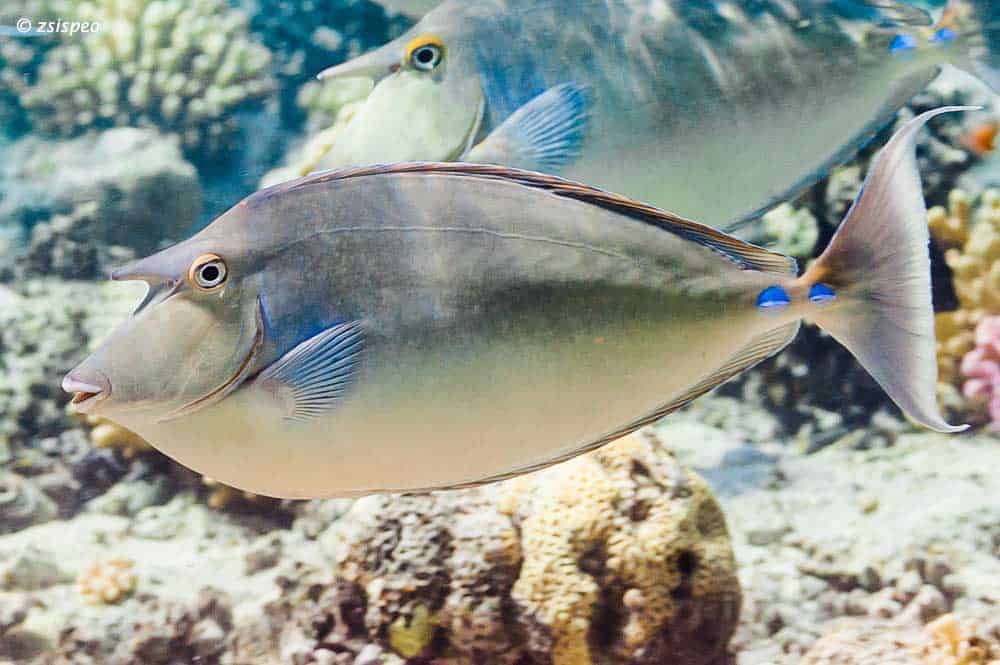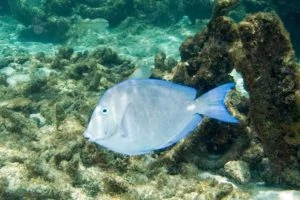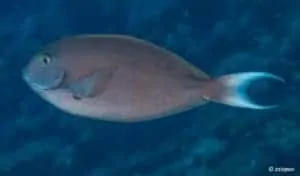Naso unicornis – Bluespine Unicornfish
Naso unicornis are members of the family Acanthuridae, commonly referred to as surgeonfish. There are 80 species in 6 different genera in this family. All have one distinguishing characteristic. They have sharp blades at the base of their tails (caudal peduncle) on both sides of their bodies used in self-defense. Seventeen of the 80 species are unicornfish. Here we will be elaborating on the Bluespine Unicornfish.
Origin
They are endemic to the Indo-Pacific from Indonesia and Christmas Island westward to the Andaman Sea, south to the eastern coast of Africa, and east to the Hawaiian Islands.
A significant populace of these creatures exists around the shores of the Hawaiian Islands. Unicorn tangs were prized by ancient Hawaiians both as a source of food and for their hides. Their tough skins were used in the construction of drum heads. This species is not considered aggressive to human intrusion. However, tourists diving off the Hawaiian Islands should avoid chasing or corning these creatures. Sports fishermen should use extreme caution when removing them from hooks or nets.

Description
Unicornfish receive their names from the horn-like projection at the top of their heads. This horn begins to develop in early adulthood. These unicorn horns will grow longer as the fish continues to mature. The function of these horns is not understood. They have yet to be observed using these spinal adaptations as a means of defense.
An unmistakable defensive mechanism employed by all members of the family Acanthuridae is the modified scale structures at the base of their tails. These structures are exceedingly sharp. When threatened, this family will thrash their tail about hoping to dissuade their aggressors from further attempts at predation. These blades will slice into flesh as efficiently as a surgeon’s scalpel. In addition to self-defense, surgeonfish use their blades to ward off intruders from their feeding grounds.

Most surgeonfish have just one set of retractable blades located in a slot on both sides of their tail. Unicorn tangs have two fixed blades on either side. These double blades are the defining characteristic of the genus Naso. This distinguishing feature helps to identify the fish’s genome. Not all unicornfish develop the horn for which they are commonly named. Unicorns have flat, teardrop-shaped bodies common to most tangs. They are bluish-grey in color and have long, flowing lyre-shaped caudal fins. The aquarium industry sells them under the pseudonyms Naso Unicornfish and Bluespine Unicornfish.
Unicorn Tangs are among the largest species made available by the aquarium industry. They can grow to a maximum adult length of 67 centimeters (27 inches). This is why you will seldom see one in a home aquarium. They require a minimum tank size of 10.000 liters (2600) gallons and are best suited for large show tanks. Because of their ties to one of the most elegant of all mythological creatures, they are prized additions to public aquaria.
Diet
Bluespine Unicornfish are herbivores. In nature, their diet consists primarily of benthic algae. Since they are unlikely candidates for home aquariums, there seems little point in covering dietary conditioning in captivity.

Mating
One of the unique aspects of surgeonfish is their communal mating habits. During spawning seasons they will congregate in large groups. Females and males simply release eggs and sperm into the water for fertilization. There is no thought of courtship or coupling found among surgeonfish in the wild.
Warning
This species has a razor-sharp blade at the base of its caudal fin. These retractable scalpel-like prongs are a natural way to defend themselves. They only unfold when the fish is excited or feels threatened. However, they can cause very deep flesh wounds, often leading to infections. The infections are characterized by swelling and discoloration of the wound. This can last for several hours. Due to the infections caused by scalpel wounds, it is suspected that they have venom glands.
Video
Author
Exotic-Aquariums (originel website no longer online)
Copyright images
Richard Ling
Brian Gratwicke zsispeo – CC BY-NC-SA 2.0
Vertaling
John de Lange

















Reviews
There are no reviews yet.